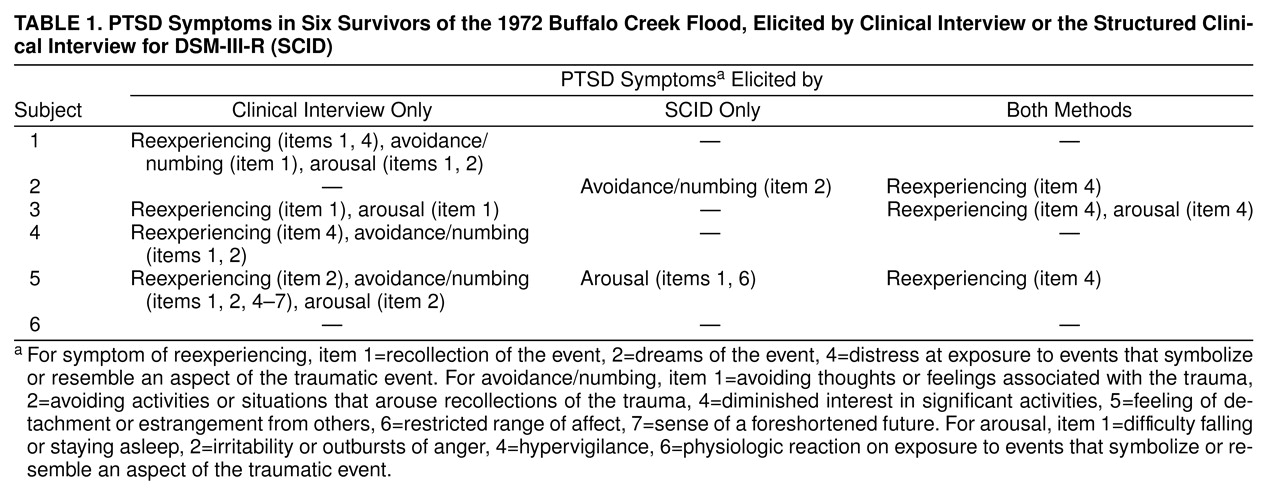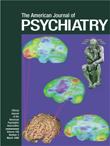The Buffalo Creek (W.Va.) flood is one of the most extensively examined and longest followed disasters in the psychiatric study of trauma. Twenty-seven years of follow-up research by teams of both psychodynamically oriented clinicians and empirically oriented researchers have stimulated a dialogue resulting in the refinement of research methods for both clinicians and empiricists.
This methodologically focused report compares the discovery of symptoms of posttraumatic stress disorder (PTSD) through use of the Structured Clinical Interview for DSM-III-R (SCID) and a semistructured psychodynamic interview. Findings indicate that especially PTSD cluster C symptoms of avoidance and numbing are more readily identified through the psychodynamic interview. Terr
(1), Solomon et al.
(2), and Koopman et al.
(3) have noted the importance of avoidance and numbing and the related phenomenon of dissociation as they relate to long-term effects of trauma.
The flood of black mud unleashed on Feb. 26, 1972, when a crudely constructed slag dam at the top of Buffalo Creek hollow collapsed, left 125 dead, 4,000 homeless, and the habitat devastated. Resident survivors sued the coal company for the haphazard construction of the dam. Damages sought included psychic impairment. Acting on behalf of the plaintiffs, the University of Cincinnati Department of Psychiatry conducted extensive assessments of 381 adult and 207 child survivors between 18 and 26 months after the flood. Study of this unprecedented postdisaster clinical record led to the description of a widespread postdisaster syndrome in both adults and children
4–
(6).
Buffalo Creek research continued into the second decade. In 1990, 99 of the originally assessed children and adolescents were interviewed with the SCID, including the PTSD segment. Results indicated that disaster-related PTSD had declined from 32% of the group in 1974 to 7% in 1990
(7). Nevertheless, investigators were reluctant to accept this group-level finding as the final word on the long-term flood effects for any particular survivor. A subsequent study enlisted teams of psychoanalytic clinicians to conduct clinical interviews to investigate in a small sample the effect that the flood may have had on the child survivors’ lives and emotional development. That study revealed that the flood did have enduring effects even though criteria for PTSD had not been met in the prior SCID interviews. Investigators concluded that rather than the presence or absence of residual PTSD, the most important long-term impact of the trauma often took the form of persistent character traits that may have originated as coping responses to the trauma
(8).
In the course of making this discovery, the research team was intrigued by the incidental finding that in several subjects, active PTSD symptoms were elicited that had not been picked up in the earlier SCID interviews. They embarked on a further study to elucidate which PTSD symptoms seemed sensitive to discovery by means of the psychodynamic interview and what aspects of this method allowed these additional PTSD symptoms to emerge.
METHOD
The protocol for the semistructured, videotaped clinical interviews, which focused on a detailed discussion of the flood and its effects, was thoroughly described in our prior report
(8). No attempt was made to comprehensively explore active PTSD symptoms because that had been the focus of the earlier SCID investigation. A total of 15 interviews were conducted from the subject pool of 99 previously evaluated by the SCID
(7); selection was determined solely by subject availability on the weekend we visited the valley. Nine interviews were audiotaped and six videotaped according to equipment availability at a particular interview site. Written informed consent was obtained from all subjects before the interviews and after a full explanation of the procedure and the purposes of the study.
The team chose to review the six videotaped clinical interviews because they would provide the best record of the interviewer/interviewee interaction. The team initially was blind to earlier SCID PTSD findings. PTSD symptoms were recorded when they were deemed exact as to DSM-III-R PTSD symptom descriptors and could be definitively linked to the flood experience. DSM-III-R PTSD descriptors were chosen for the purpose of comparison with the prior SCID data. Also carefully studied was the interviewing process as the PTSD symptoms emerged, including rapport, affective tone, and the handling of resistance.
RESULTS
Four of the six subjects showed PTSD symptoms not reported during the prior SCID interview. Two of the six subjects reported to the SCID interviewers PTSD symptoms that were not discovered in the review of the clinical interviews. Of 25 PTSD symptoms for the six subjects that were elicited by the two methods combined, 18 were elicited only by means of the clinical interview and three only by means of the SCID. Of the 18 PTSD symptoms discovered exclusively by the clinical method, five were PTSD cluster B symptoms of reexperiencing, nine were cluster C symptoms of avoidance and numbing, and four were cluster D symptoms of arousal (
table 1).
An additional finding was that four of the six subjects reported in their clinical interviews flood-related symptoms not described in the DSM-III-R PTSD survey. These included survivor guilt, obsessive feelings of responsibility, persistent rage toward the perceived perpetrators of the flood, preoccupation with thoughts of death, and counterphobic behavior in the face of current physical danger.
DISCUSSION
The findings that two-thirds of our subjects revealed symptoms of PTSD not reported in the prior SCID interview and that 72% of the total PTSD symptoms were discovered only by means of the clinical interview appear compelling regarding the inclusion of this method in the investigation of the long-term effects of trauma. Most particularly, the finding that of the 10 cluster C symptoms discovered, nine were elicited only by the psychodynamic clinical interview raises serious concern about whether symptoms characterized by avoidance and numbing of general responsiveness can be reliably detected by standardized interviewing technique. This problem was earlier recognized by the PTSD Advisory Committee for DSM-IV, which noted the problem with standardized methodology in operationalizing criteria for the assessment of such symptoms of avoidance and numbing as denial, psychogenic amnesia, and the sense of a foreshortened future
(9). The psychodynamic interview, by virtue of its sensitivity to manifestations of resistance as they emerge in the clinical encounter, would be more likely to elicit symptoms of avoidance and numbing, which we have hypothesized as likely to evolve into long-term personality change if the initial psychological impact of the trauma is left untreated
(8).
We envision further collaborative investigations whereby a more rigorous method might be developed to compare clinical and empirical findings. The enormous toll paid by individuals and society for the underdiagnosed and untreated sequelae of trauma compels further thoughtful consideration of this issue.


